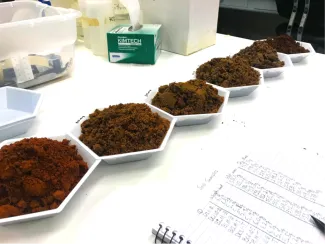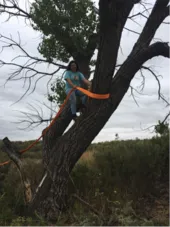
The entire month of October was spent trapping at Packsaddle WMA, resulting in 18 new quail fitted with transmitters. The unexpectedly low trapping success at Packsaddle suggested comparatively low densities of quail at this location. Ten downed transmitters were recovered during October, with five recovered from Beaver River WMA and five from Packsaddle WMA. Nine showed obvious signs of predation, with five being attributed to mammal predation, two to raptor predation, and two to unknown predation. One quail was determined to have been scavenged after its death and a cause of death could therefore not be assigned.

During October, there were a total of 37 active transmitters across three of the four WMAs, with 21 active GPS transmitters at Packsaddle, 13 at Beaver River, and three at Cross Timbers. All transmitters, except three at Packsaddle, were of the type with satellite-download. In total, 40,741 individual locations since the launch of the first transmitter in July 2018 have now been collected. Computerization of vegetation data collected during the past summer has continued and preliminary analyses of bird survey data and vegetation data have begun, as well as movement data from the GPS transmitters.

For the invertebrate part of the project, 190 of the 480 pitfall samples and 70 of the 90 nutrient samples had been processed by the end of October. Nutrient samples collected in both May and July have all been sorted by invertebrate order and size class (all samples remaining were collected in June), and it appears that there is size variation in several groups of invertebrates between months. For example, in May, the majority of Orthopterans (grasshoppers and crickets) are of the 5–10 mm size class, which are appropriately sized prey items for bobwhite chicks. However, in July, there are far more Orthopterans of the >15 mm size class than any other size. Additionally, soil samples collected have begun drying (roughly 50 percent complete) and soil drying should be completed by the end of the first week of November. These samples will be combusted for soil organic matter analysis, and this data will be used to examine how disking and burning alter soil moisture and organic matter content. Changes in soil moisture and organic matter content could influence the presence and abundance of detritivorous arthropods. Data on soil type will also be collected from soil maps of Packsaddle and used in analyses.
Quail season is now open. For complete information and license requirements, see the current Oklahoma Hunting and Fishing Regulations Guide found online at wildlifedepartment.com, on the Go Outdoors Oklahoma free mobile app for Apple or Android devices, or in print across the state wherever hunting and fishing licenses are sold.